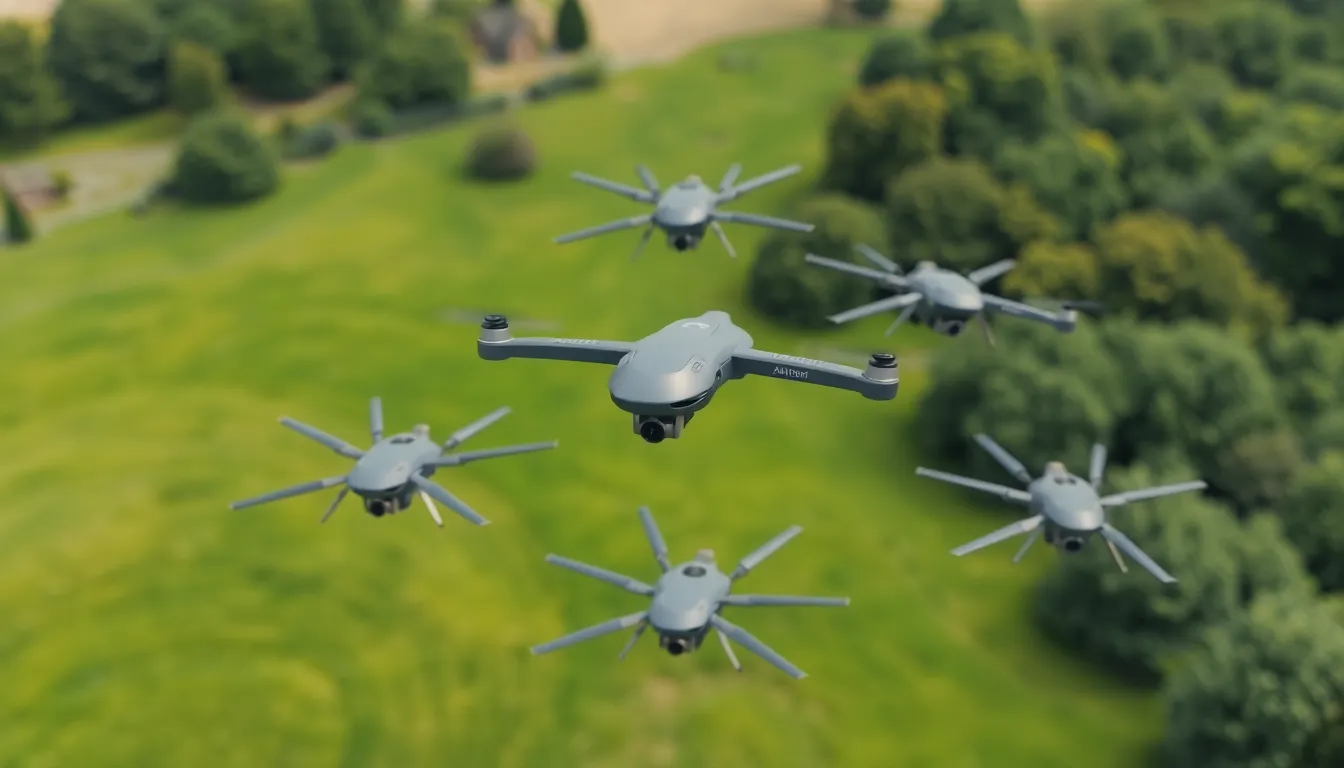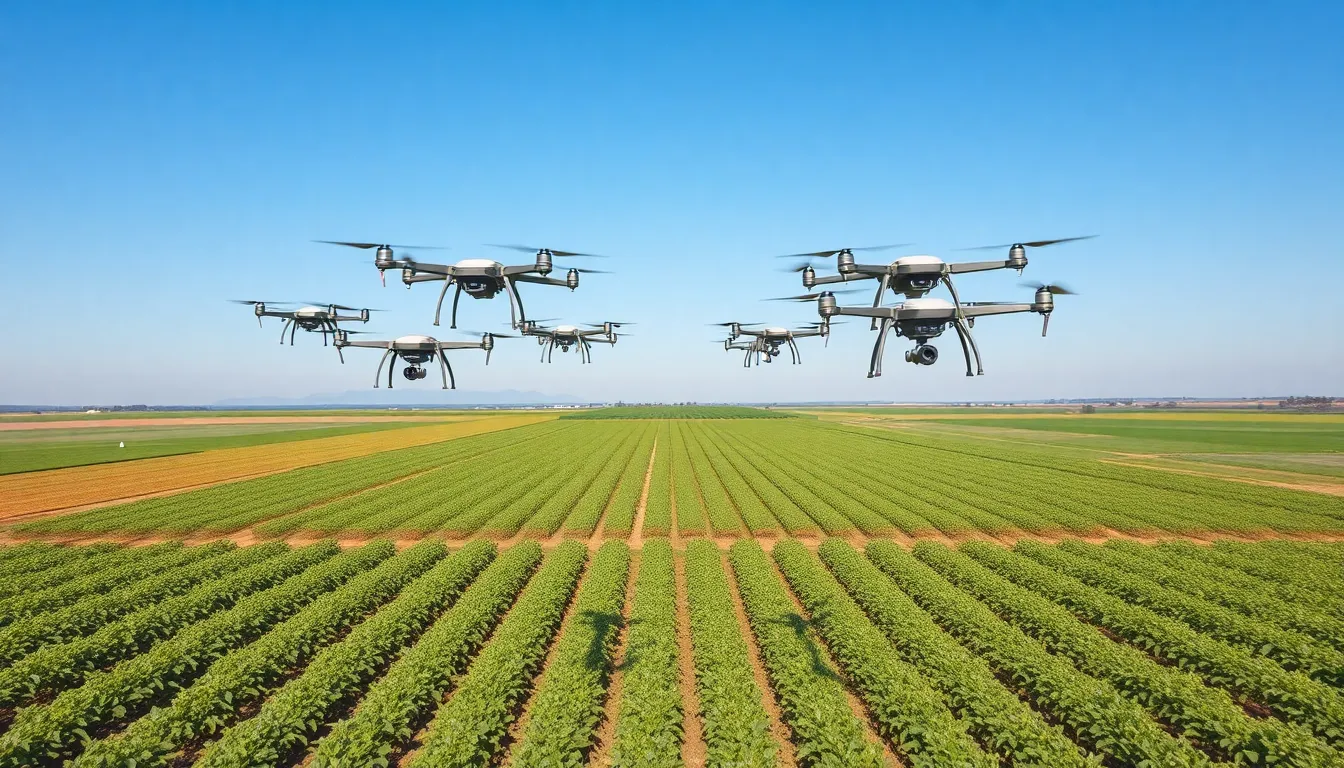Imagine a fleet of tiny flying robots working together like a well-choreographed dance team. That’s the magic of swarm drones. These little aerial marvels don’t just buzz around aimlessly; they communicate, collaborate, and tackle complex tasks with the finesse of a synchronized swimming routine—minus the water and the sequins.
Table of Contents
ToggleOverview Of Swarm Drones
Swarm drones consist of multiple autonomous aerial vehicles working together to accomplish tasks. These drones utilize advanced algorithms that enable them to share information quickly and efficiently. Coordination among drones enhances their ability to adapt to changing environments and respond to specific challenges.
Each drone operates with a level of autonomy, allowing it to make real-time decisions based on input from other units. This decentralized structure differs from traditional UAV systems controlled from a single point, leading to improved resilience in operations. Swarm drones can cover vast areas, making them suitable for applications such as search and rescue missions, agricultural monitoring, and even military operations.
Collaboration is central to the effectiveness of swarm drones. By mimicking natural swarms, like flocks of birds or schools of fish, these drones achieve optimal results without needing direct human control. Research shows that swarm technology can significantly enhance task efficiency. For example, a study found that swarm drones could complete mapping tasks in half the time of a single drone.
This technology continues to evolve as developers explore new ways to enhance communication and navigation capabilities. Implementing artificial intelligence into swarm algorithms opens the door for more sophisticated behaviors. Consequently, these advancements promise a future where swarm drones can perform increasingly complex missions with little input from human operators.
Overall, swarm drones represent a significant leap in drone technology, enabling revolutionary applications across various fields. Their ability to work collectively leads to enhanced performance and versatility in operational tasks.
How Swarm Drones Operate

Swarm drones operate through coordinated teamwork, leveraging technology to achieve complex tasks efficiently. Their functionality stems from advanced algorithms, allowing for dynamic responses to environmental changes.
Principles Of Swarm Intelligence
Swarm intelligence relies on the behaviors observed in natural swarms like flocks of birds or schools of fish. Each drone, as an individual unit, follows simple rules that contribute to the group’s overall goals. Local interactions among drones facilitate collective problem-solving. For instance, when they encounter obstacles, they share information, ensuring the entire swarm navigates effectively. This decentralized decision-making structure enhances flexibility and adaptability.
Communication Methods Among Drones
Drones communicate using various effective methods. Many utilize radio frequency signals for real-time data sharing. In addition, some drones may use light signals or acoustic waves, enhancing communication in specific scenarios. Information exchange occurs quickly, enabling rapid decision-making and task execution. Each drone’s sensors continuously gather and relay data to peers, creating a responsive network. Such communication methods allow drones to maintain awareness of their surroundings, reinforcing the group’s collective intelligence.
Applications Of Swarm Drones
Swarm drones demonstrate versatile applications across various fields. Their efficiency in teamwork leads to numerous innovative solutions.
Military Uses
Military operations increasingly rely on swarm drones for tactical advantages. Swarm drones can conduct reconnaissance missions efficiently, providing real-time surveillance over vast areas. They enhance communication by sharing data among units, which improves situational awareness on the battlefield. Attack patterns may also benefit, utilizing coordinated strikes that overwhelm enemy defenses. Additionally, swarm drones support logistics by delivering supplies to remote locations, ensuring troops receive necessary resources swiftly.
Commercial Uses
Commercial sectors utilize swarm drones for various tasks. Agriculture represents a significant area where swarm drones monitor crop health, assess soil conditions, and optimize resource usage. Retailers benefit from inventory management by using drones to track stock levels in large warehouses. Moreover, entertainment industries employ swarms for light shows, creating visually stunning displays using coordinated movements. Furthermore, infrastructure inspection has become safer and more efficient, allowing for inspections of pipelines and bridges in hard-to-reach areas.
Environmental Monitoring
Environmental monitoring has greatly improved with swarm drones. These drones effectively collect data on air quality, water sources, and wildlife populations. They continuously monitor ecosystems, enabling researchers to track changes and identify potential threats. During natural disasters, swarm drones assess damage, providing timely information for response efforts. Their ability to cover wide areas makes them invaluable in combating illegal deforestation and poaching, fostering greater environmental protection. Through collaboration, swarm drones significantly enhance the effectiveness of conservation initiatives.
Challenges In Swarm Drone Technology
Swarm drone technology faces significant challenges that could impact their effectiveness.
Technical Limitations
Technical limitations hinder the full potential of swarm drones. Communication systems often encounter interference or range issues, affecting real-time data sharing. Battery life remains a critical concern, with many drones requiring frequent recharging in extensive operations. Processing power is another limitation, as some drones struggle to manage complex algorithms while flying. Obstacle detection and avoidance also present challenges, as terrain variations can confuse sensors, leading to potential collisions. Additionally, ensuring seamless coordination among numerous drones requires advanced algorithms that are still in development.
Regulatory Hurdles
Regulatory hurdles slow the adoption of swarm drone technology. Aviation authorities impose restrictions on drone operations, particularly regarding airspace usage and altitude limits. Privacy concerns arise as the use of drones can lead to surveillance implications, prompting stricter regulations. Compliance with local and international laws creates complexities for developers and operators. Permit acquisition takes time, delaying project implementations and testing. Engaging with policymakers remains essential to shaping favorable regulations that support innovation while ensuring safety.
Future Of Swarm Drones
Swarm drones represent a rapidly evolving technology with significant future potential. As advancements continue, they promise to revolutionize various sectors.
Innovations On The Horizon
Emerging technologies enhance the performance and capabilities of swarm drones. Researchers are focusing on improving algorithms for better decision-making and autonomy. Artificial intelligence integration enables drones to learn from experience, leading to more efficient missions. Furthermore, developments in communication technology, such as low-latency data transfer, facilitate more effective collaboration. Miniaturization of components reduces size while increasing battery life, allowing for longer operational durations. Solutions for obstacle detection and navigation further support enhanced functionality. Innovations in materials develop more resilient drones that withstand environmental challenges. Collectively, these advancements create a future where swarm drones operate seamlessly in complex environments.
Potential Impact On Industries
Various industries stand to benefit substantially from swarm drones. In agriculture, farmers utilize drone fleets for efficient crop monitoring, enabling precise irrigation and pest control. Logistics companies enhance inventory management through automated drone deliveries, reducing transportation costs. Environmental research gains momentum, with swarm drones gathering data on ecosystems quickly and comprehensively. Military operations experience increased efficiency, thanks to drones enabling responsive strategies during missions. Recreational sectors leverage swarm technology for entertainment, creating captivating light displays at events. Overall, swarm drones reshape and redefine operational models across numerous fields.
Swarm drones represent a transformative leap in aerial technology. Their ability to operate in unison through advanced algorithms and communication methods enables them to tackle complex tasks with remarkable efficiency. As they continue to evolve, their applications will expand across various sectors, from agriculture to military operations, enhancing productivity and effectiveness.
However, challenges remain that must be addressed to unlock their full potential. Technical limitations and regulatory hurdles pose significant obstacles. As innovations in artificial intelligence and communication technology progress, swarm drones are poised to redefine operational capabilities, paving the way for a future where they seamlessly integrate into everyday tasks. The journey of swarm drones is just beginning, and their impact on multiple industries will be profound.



